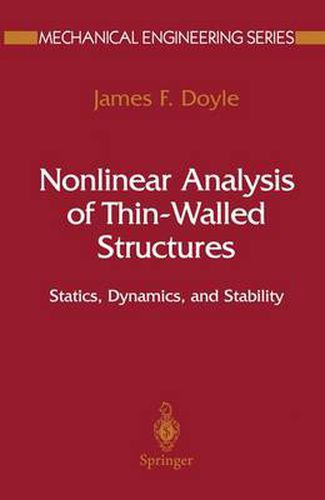Readings Newsletter
Become a Readings Member to make your shopping experience even easier.
Sign in or sign up for free!
You’re not far away from qualifying for FREE standard shipping within Australia
You’ve qualified for FREE standard shipping within Australia
The cart is loading…






This title is printed to order. This book may have been self-published. If so, we cannot guarantee the quality of the content. In the main most books will have gone through the editing process however some may not. We therefore suggest that you be aware of this before ordering this book. If in doubt check either the author or publisher’s details as we are unable to accept any returns unless they are faulty. Please contact us if you have any questions.
This book deals with the computational analysis of thin-walled structures such as aircraft, ships, and containment vessels. Building on the author’s earlier book Static and Dynamic Analysis of Structures, it shows how to use computational methods to tackle some of the fundamental problems of structural mechanics, with particular emphasis on nonlinear phenomena. Where the earlier book dealt with linear systems, the central theme running through this volume is the notion that unstable equilibria are associated with motions and large displacements and therefore require a full nonlinear analysis.The discussion begins with an overview of the basic mechanics of deformable bodies, including variational formulations, and then considers the large deflection behavior of shell and frame structures using a finite-element analysis. The second part of the book begins with a summary of linear vibrations of structures, including an introduction to modal analysis; it continues with computational formulations of nonlinear dynamic analyses of structures and refines the concept of dynamic equilibrium in the context of large deflections. The book concludes with a discussion of stability, including the difficult problem of stability of motions in the large.By describing the methods on which commercial software pakckages are based, this book allows an engineer to evaluate the results these computations produce. It therefore should be useful to practicing engineers and graduate students.
$9.00 standard shipping within Australia
FREE standard shipping within Australia for orders over $100.00
Express & International shipping calculated at checkout
This title is printed to order. This book may have been self-published. If so, we cannot guarantee the quality of the content. In the main most books will have gone through the editing process however some may not. We therefore suggest that you be aware of this before ordering this book. If in doubt check either the author or publisher’s details as we are unable to accept any returns unless they are faulty. Please contact us if you have any questions.
This book deals with the computational analysis of thin-walled structures such as aircraft, ships, and containment vessels. Building on the author’s earlier book Static and Dynamic Analysis of Structures, it shows how to use computational methods to tackle some of the fundamental problems of structural mechanics, with particular emphasis on nonlinear phenomena. Where the earlier book dealt with linear systems, the central theme running through this volume is the notion that unstable equilibria are associated with motions and large displacements and therefore require a full nonlinear analysis.The discussion begins with an overview of the basic mechanics of deformable bodies, including variational formulations, and then considers the large deflection behavior of shell and frame structures using a finite-element analysis. The second part of the book begins with a summary of linear vibrations of structures, including an introduction to modal analysis; it continues with computational formulations of nonlinear dynamic analyses of structures and refines the concept of dynamic equilibrium in the context of large deflections. The book concludes with a discussion of stability, including the difficult problem of stability of motions in the large.By describing the methods on which commercial software pakckages are based, this book allows an engineer to evaluate the results these computations produce. It therefore should be useful to practicing engineers and graduate students.